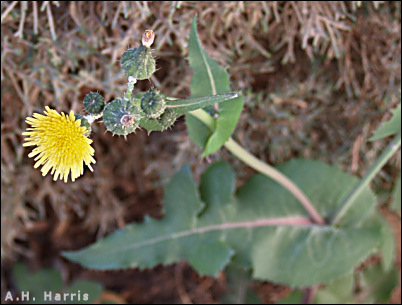

It seems strange that so many of our plants and animals wouldn't have been familiar at all to North America's inhabitants of only a few hundred years ago. Unlike earlier immigrants, European colonists had the advantage of conveyances that could carry large amounts of cargo. And so they and their descendants did. Along with such niceties as apple and peach trees, sheep and goats, cattle and horses, came small pox and malaria, Old World Rats and Mice, and a virtual firestorm of weeds.
Some weeds, like tumbleweed, have entered into folklore; others, such
as Salt Cedar, or Tamarisk, into infamy. With all this said, though, some of these
exotic plants seem to do little harm and may even present a note of cheer. A few, such
as the dandelion, seem to have the dual functions of inducing apoplexy into lawn owners
and delight to lovers of bright, cheery flowers. In the latter category, let's
include Sonchus, also known as sowthistle, who looks something like a dandelion
grown up with a crewcut, but is really just another cheery yellow face.

Listen to the audio.
Contributor: Arthur H. Harris, Laboratory for Environmental Biology, Centennial Museum, University of Texas at El Paso.
Desert Diary is a production of KTEP, National Public Radio at the University of Texas at El Paso.

Sowthistle in flower. Image by A.H. Harris.
Image Archive of Central Texas Plants